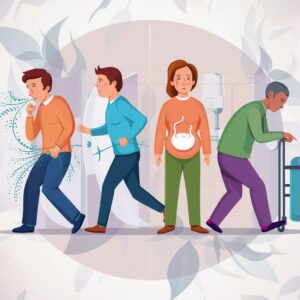Treatment Options for Incontinence Management
Incontinence is a widespread medical disease that impacts many individuals worldwide. It describes the involuntary passage of bodily fluids, such as urine or excrement, which can substantially negatively affect a person's overall well-being. The four primary categories of incontinence are stress, urge, overflow, and functional incontinence.
Every category has unique causes and symptoms. Stress incontinence is the involuntary leakage of pee that happens when the bladder is subjected to pressure. This can occur during coughing, sneezing, laughing, or exercising.
Urge incontinence is defined as a sudden and overwhelming urge to urinate, followed by the involuntary leakage of urine. When the bladder does not empty, overflow incontinence results in frequent or continuous pee dribbling. Functional incontinence commonly occurs when a person cannot reach the toilet promptly due to physical or cognitive limitations.
The aetiology of incontinence varies depending on the type. Stress incontinence often occurs due to weakening pelvic floor muscles, whereas urge incontinence may be associated with an overactive bladder or nerve impairment. Additional possible factors are urinary tract infections, constipation, specific drugs, and neurological diseases.
The symptoms of incontinence vary from slight leaking to total loss of bladder or bowel control. Individuals experiencing symptoms of incontinence should prioritise seeking medical consultation to identify the root cause and explore suitable treatment options.
Key Takeaways
- Incontinence can be caused by various factors, including weakened pelvic floor muscles, nerve damage, and certain medical conditions.
- Lifestyle changes such as maintaining a healthy weight, avoiding bladder irritants, and practising bladder training can help manage incontinence symptoms.
- Medications like anticholinergics and mirabegron can be prescribed to help control overactive bladder and reduce incontinence episodes.
- Pelvic floor exercises, also known as Kegels, and physical therapy can strengthen the pelvic floor muscles and improve bladder control.
- Surgical options, such as sling procedures and bladder neck suspension, may be considered for severe cases of incontinence that do not respond to other treatments.
 Lifestyle Changes and Behavioral Therapy for Incontinence
Lifestyle Changes and Behavioral Therapy for Incontinence
Dietary Adjustments
Making simple adjustments to daily habits can significantly reduce the frequency and severity of incontinence episodes. For example, reducing fluid intake, especially before bedtime, can help minimise the need to urinate during the night. Avoiding caffeine and alcohol, which can irritate the bladder and increase urine production, may also be beneficial.
Physical Activity and Weight Management
In addition to dietary changes, maintaining a healthy weight and engaging in regular physical activity can help strengthen the pelvic floor muscles and improve bladder control. Quitting smoking is also important, as smoking can contribute to coughing and bladder irritation, which can exacerbate incontinence symptoms.
Behavioural Therapy Techniques
Behavioural therapy techniques, such as bladder training and scheduled voiding, can help individuals regain control over their bladder function. These techniques involve gradually increasing the time between bathroom visits and learning to recognise and respond to the body's signals for urination. Furthermore, practising good toilet habits, such as taking enough time to empty the bladder and using relaxation techniques to reduce urgency, can also be helpful.
Additional Therapies
In some cases, biofeedback therapy or electrical stimulation may be recommended to help individuals gain better control over their pelvic floor muscles. By implementing these lifestyle changes and behavioural therapy techniques, many individuals with incontinence can experience significant improvement in their symptoms and regain confidence in their daily activities.
Medication Options for Managing Incontinence
Aside from making adjustments to one's lifestyle and undergoing behavioural therapy, other pharmacological choices can be used to manage incontinence effectively. The choice of medication provided will be contingent upon the incontinence's precise classification and underlying aetiology. Anticholinergic drugs are frequently employed to manage urge incontinence by inducing relaxation in the muscles of the bladder and diminishing the frequency of contractions.
These drugs can alleviate the abrupt and severe need to urinate, indicative of urge incontinence. Mirabegron is a medicine that can be administered to treat incontinence. It relaxes the bladder muscle and enhances its ability to retain urine. This medicine is commonly used for the treatment of symptoms associated with an overactive bladder, for example, the sudden and consistent urge to pee.
Topical oestrogen therapy may be prescribed for persons experiencing stress incontinence to enhance the resilience and flexibility of the tissues in the urethra and vaginal region. Tricyclic antidepressants or other drugs that impact nerve signals may be used in certain instances to assist in managing symptoms of incontinence. Individuals who are exploring drug choices for incontinence should consult a healthcare expert to establish the most suitable treatment based on their specific symptoms and medical history.
Although drugs can effectively manage incontinence for certain persons, it is essential to scrutinise their potential adverse effects.
 Pelvic Floor Exercises and Physical Therapy for Incontinence
Pelvic Floor Exercises and Physical Therapy for Incontinence
Pelvic floor exercises, usually Kegel exercises, are essential to physical therapy for managing incontinence. These exercises entail contracting and relaxing the muscles in the pelvic floor to enhance strength and control. By fortifying these muscles, individuals can improve their ability to support the bladder and bowel, decreasing the likelihood of leakage and gaining control and independence.
Pelvic floor exercises are especially advantageous for patients experiencing stress incontinence, as they enhance the capacity to retain urine during activities that exert pressure on the bladder. Physical therapy for the pelvic floor may incorporate several modalities, including biofeedback. Biofeedback employs sensors to offer visual or aural cues regarding muscle activity, aiding individuals in acquiring the skill to contract and release their pelvic floor muscles effectively by applying gentle electrical pulses to the area. It is possible to enhance pelvic floor muscle strength with electrical stimulation.
Specialised physical therapists in pelvic floor rehabilitation collaborate with patients to create customised training regimens tailored to their unique requirements and objectives. These programs may also incorporate stretches and strengthening exercises targeting additional muscle groups that support pelvic floor function. Engaging in physical therapy for incontinence can enhance patients' muscular strength and coordination, resulting in enhanced bladder control and fewer incontinence symptoms.
Surgical Options for Incontinence Treatment
Surgical interventions may be explored for those with severe or persistent incontinence that does not improve with conservative therapy. Various surgical interventions are available to treat different forms of incontinence, with each technique targeting the root cause of the disease. A frequently used surgical treatment for stress incontinence is the sling operation. This procedure entails placing a supporting sling over the urethra to offer extra support and prevent leakage when engaging in activities that strain the bladder.
A bladder neck suspension is an additional surgical technique used to treat stress incontinence. It involves attaching the neck of the bladder to adjacent structures to enhance the regulation of urine flow. For those with symptoms of an overactive bladder or urge incontinence, sacral neuromodulation may be recommended. This treatment involves placing a miniature device near the sacral nerves to regulate nerve signals associated with bladder function, diminishing the urgency and frequency of urinating.
Occasionally, surgical interventions for incontinence may involve procedures to rectify anatomical anomalies or treat underlying disorders that contribute to symptoms. Before making a decision, individuals contemplating surgical intervention for incontinence should thoroughly discuss the prospective hazards and advantages with a healthcare professional and thoughtfully evaluate their alternatives.
Incontinence Products and Devices for Management
Absorbent Products
Disposable absorbent products, such as pads, liners, and adult diapers, are commonly used to manage urinary or faecal incontinence. These products come in various sizes and absorbency levels to meet individual needs. Reusable absorbent underwear and protective garments are also available for those looking for more sustainable options.
Assistive Devices
For individuals with mobility limitations or difficulty reaching the toilet in time, portable urinals or bedpans may help manage urinary incontinence. Male external catheters and female urinary collection devices are also available for individuals who require assistance with urinary drainage.
Skin and Odor Care
In addition to absorbent products, skin care products such as barrier creams and cleansing wipes can help prevent irritation and discomfort associated with frequent exposure to urine or faeces. Odour control products, such as deodorising sprays or pouches, are also available to help manage unpleasant odours associated with incontinence.
 Combining Therapy Options for Effective Incontinence Management
Combining Therapy Options for Effective Incontinence Management
A combination of therapy approaches is often required for effective incontinence management. For instance, a person with stress incontinence can find relief by engaging in pelvic floor exercises to fortify the muscles that support the bladder. Additionally, lifestyle adjustments such as managing weight and making food alterations can help alleviate strain on the bladder. Similarly, a person with urge incontinence may find relief through pharmacotherapy to decrease the urgency and frequency of urine. Behavioural therapy strategies like bladder training can help regain control over bladder function.
Individuals with incontinence caused by several factors or complex conditions may require a comprehensive approach that incorporates various therapy approaches to control their symptoms effectively. This comprehensive care is provided by a healthcare team comprising physicians, physical therapists, occupational therapists, and other specialists. They provide individualised care based on their requirements to make people feel supported and cared for. By integrating several therapeutic approaches, persons can achieve an enhanced quality of life and restore their self-assurance in everyday activities without apprehension or unease related to incontinence.
Individuals suffering from incontinence should see healthcare professionals for assistance with the various treatment choices and to create a customised strategy that caters to their specific needs and objectives.
FAQs
What is incontinence therapy?
Incontinence therapy refers to the various treatments and interventions to manage and improve urinary or faecal incontinence symptoms. These therapies can include lifestyle changes, pelvic floor exercises, medication, medical devices, and, in some cases, surgery.
What are the common causes of incontinence?
Incontinence can be caused by a variety of factors, including weakened pelvic floor muscles, nerve damage, urinary tract infections, certain medications, and underlying medical conditions such as diabetes, Parkinson's disease, or prostate issues in men.
What are the different types of incontinence therapy?
Incontinence therapy can include pelvic floor muscle exercises (Kegel exercises), bladder training, dietary and fluid management, medication, biofeedback, electrical stimulation, and, in some cases, surgical interventions such as sling procedures or artificial urinary sphincter implants.
How effective is incontinence therapy?
The effectiveness of incontinence therapy can vary depending on the individual and the underlying cause. Many people experience significant improvement in their symptoms with the appropriate therapy, while others may require a combination of treatments to achieve the desired results.
Does insurance cover incontinence therapy?
In many cases, incontinence therapy and related treatments are covered by health insurance. However, coverage can vary depending on the specific insurance plan and the recommended therapy type. It's important to check with your insurance provider to understand what is covered and what out-of-pocket costs may be involved.
Brought To You By:
References
Tips for Dealing with Urinary Incontinence (For Men) | OncoLink. https://www.oncolink.org/support/practical-and-emotional/physical-concerns/tips-for-dealing-with-urinary-incontinence-for-men
Understanding Incontinence and Its Effects – P Homecare. https://www.phomecare.com.au/2023/05/16/understanding-incontinence-and-its-effects/
The Article: Managing Incontinence Effective Therapy Options appeared first on https://mcrtherapies.co.uk
The Article Managing Incontinence Effective Therapy Options appeared first on https://mcrtherapies.com
The Article Managing Incontinence Effective Therapy Options Was Found On https://limitsofstrategy.com
The Article Managing Incontinence Effective Therapy Options First Appeared ON
: https://ad4sc.com


Incontinence can bring up such a range of feelings, can’t it? I appreciate how you broke down the different types so clearly. Stress incontinence, for instance, often feels like it’s tied not just to physical reactions but also cultural expectations around body image and physical activity — I’ve heard from friends who are hesitant to exercise due to fear of leakage, which really highlights how it can affect one’s lifestyle and self-esteem.
You bring up such an important point about how incontinence doesn’t just affect the physical side of things; it really seeps into emotional and social aspects of our lives. It’s frustrating that something as natural as bodily functions can make people hesitate to do activities they enjoy, like exercise, because of the fear of leakage. It’s almost like a double whammy—you’re dealing with the physical challenge, but then there’s this whole mental game that plays out, which can lead to feeling isolated or even ashamed, especially in environments that often focus so heavily on body image and appearance.
“Hey there! If you’re curious and ready for some cool insights, check this out—it’s definitely worth a peek!”
https://oldicom.net/webilaro
You make a really insightful observation about the emotional and social implications of incontinence. It’s true that living with such a condition often extends beyond the physical challenges—it can create a ripple effect that impacts confidence and social engagements. I’ve spoken to several people who’ve shared how the fear of leakage has kept them from enjoying workouts or social events. It’s unfortunate when something so natural leads to feelings of shame or isolation.
You raise such a crucial point about the emotional and social impact of incontinence. It really is disheartening that something so natural can lead to feelings of shame and isolation. You’re right—it’s almost as if there’s a silent stigma surrounding it, especially in spaces where physical appearance and body image can feel so scrutinized.
It’s interesting how incontinence is rarely talked about but affects so many lives. I’ve seen it impact family members, and it’s a tough topic because of the stigma around it. The challenges vary widely depending on the type; for instance, I know people who have dealt with urge incontinence and how it disrupts their daily activities. Plus, the solutions can be just as diverse – from pelvic floor therapy to lifestyle changes. It’s such a reminder of how important it is to address these issues openly and encourage innovation in treatment. I wonder if newer technologies, like apps that track symptoms or virtual support groups, could help people manage this condition better. Has anyone experienced any new approaches or technologies that have worked for them?
I completely empathize with your observations about incontinence. It’s definitely one of those issues that doesn’t get the attention it deserves, largely due to societal stigma. I’ve noticed how it can change the dynamics of family and social interactions, especially for those who feel they need to hide it.
You’ve hit on a crucial point about how incontinence reshapes not just individual lives but family relationships and social settings. It’s fascinating—and a bit disheartening—how so many people end up hiding a part of themselves that’s so deeply personal. That secrecy can create walls, both for the person experiencing it and for their loved ones who might feel confused or distanced by the change in dynamics.
You’ve really pinpointed something that resonates on multiple levels. The way incontinence transforms not just an individual’s day-to-day but also the dynamics within families and social groups is profound. What strikes me is how our culture often emphasizes physical ability and independence, which can make the act of sharing such a personal challenge feel intimidating, if not impossible.
You’ve really pinpointed something that resonates on multiple levels. It’s interesting how incontinence can feel like this invisible thread weaving through relationships. I’ve seen it firsthand in a friend’s family, where it shifted not just daily routines but also how they interacted with one another. Suddenly, vulnerability was the new norm, and they had to grapple with those feelings of shame and frustration together.
You’ve touched on such an important reality that so many people experience but often feel they have to keep to themselves. The pressure to maintain a facade of independence can be heavy, especially when everyday challenges become part of the picture. It’s those private struggles that can quietly influence how families interact, and how we relate to one another in broader social settings.
You bring up such a vital point about how incontinence shifts not only an individual’s experience but also ripples through family and social dynamics. It’s like you mentioned; that pressure from our culture to always appear strong and self-sufficient can make it really tough to open up about something so personal. It’s almost like we’re taught to put on a brave face and keep things together, which can feel incredibly isolating when you’re struggling with something that feels stigmatized.
You hit the nail on the head. The idea that we need to walk around with an air of invincibility can be exhausting. I mean, who decided that we all should be emotional superheroes? It’s exhausting to juggle the whole “keep calm and carry on” mantra while dealing with something as mundane yet impactful as incontinence. Like, I don’t remember signing up for this performance art where I have to act like nothing bothers me.
You’ve really captured the complexity of how incontinence can affect not just the individual but their entire support system. It’s interesting to think about how societal perceptions of bodily functions can lead to such isolation. I’ve seen this play out in various ways, whether it’s through friends who shy away from social gatherings or family members feeling unsure of how to support their loved ones.
You’ve hit on a crucial point about the isolation that can stem from societal perceptions around these bodily functions. It’s striking how the stigma can ripple outward, impacting not just the person experiencing incontinence but also their friends and family. Many people feel unsure about how to engage, which can lead to avoidance.
“Absolutely, the ripple effects of incontinence can be profound. If you’re interested in exploring ways to foster understanding and support for those affected, check out this resource that offers valuable insights.”
https://oldicom.net/quillbot
You’ve nailed an important point about how incontinence doesn’t just sideline the individual but can ripple out to affect friends and family. It’s wild how societal views can create this stigma that leads to withdrawal. I’ve seen it, too—friends who become hesitant to join activities or family members unsure how to engage without making things awkward. It really highlights the need for open conversations. If everyone could chat more openly about these issues, it could ease some of that isolation. Building a supportive network can make a huge difference, even if it starts with small, honest discussions at home. It all contributes to a more understanding community overall.
You’ve touched on something really crucial here—the ripple effect of incontinence on the people around us. It’s interesting how so often, the emphasis is on the individual experiencing the condition, but as you pointed out, it can create a kind of hesitation not just for them but also for friends and family. It’s like a shadow that spreads out, impacting social dynamics in ways that many people don’t realize until they see it unfold.
I agree that incontinence is an issue that often gets swept under the rug, primarily because of the stigma surrounding it. It’s not just about the physical aspects; the emotional and social impacts can be profound. I’ve seen how it affects individuals, often leading them to avoid gatherings or even close family events just to sidestep potential embarrassment. It’s sad because it can create unnecessary barriers between people.
You’ve touched on a key point that really resonates with many people. The emotional and social impacts of incontinence often remain in the shadows, overshadowed by the discomfort surrounding the topic. It’s tough to witness how some individuals retreat from social scenarios, missing out on important moments simply to avoid a potential situation.
You’ve hit on a key point. The stigma surrounding incontinence not only affects individuals but also puts strain on how families interact. Many people feel like they have to navigate their social lives in secrecy, leading to a sense of isolation.
You’ve touched on something really important—how incontinence isn’t just a physical issue, but a social one too. The stigma surrounding it can really create a barrier, making people feel isolated in their experience. It’s interesting how something so common can be so rarely discussed, leaving many to grapple with their feelings alone.
Absolutely, the impact of incontinence on personal relationships can be profound. For those looking for supportive resources and solutions, I invite you to explore this link for more information.
https://oldicom.net/quillbot
Incontinence is such a nuanced topic, and it’s refreshing to see it addressed with the seriousness it deserves. Personally, I’ve witnessed the impact of incontinence on loved ones, and it definitely goes beyond just the physical symptoms. There’s a significant emotional and social toll that often comes with it. For instance, I remember my grandmother struggling with urge incontinence—she was always so active and independent, yet this condition made her reluctant to leave the house, even for family gatherings. It’s heartbreaking to see someone’s quality of life diminished by something that isn’t often talked about openly.
It’s true; incontinence can be so layered and often touches on aspects that aren’t front and center in conversations. The emotional and social repercussions really hit home, especially when you see someone you love experience it. Your grandmother’s story resonates deeply. It’s a reminder of how interconnected our physical health is with our emotional well-being.
You bring up such an important point about the deep interplay between physical health and emotional well-being. I often think about how incontinence, while a physical condition, can create ripples in one’s overall sense of self and dignity. When I watched my grandmother navigate this, it was heartbreaking to see her transition from someone full of life to feeling increasingly isolated.
You’ve captured a really important aspect of incontinence that often gets overlooked. It’s easy to think about the physical challenges it presents, but the emotional and social ripples are just as significant—and, as you pointed out, they can be particularly painful to witness in loved ones.
“Absolutely, the interconnectedness of physical and emotional health is so important to acknowledge. If you’re interested in exploring more about this topic and finding supportive resources, check out this link.”
https://oldicom.net/webilaro
You bring up such a powerful point about the emotional and social toll that incontinence can have. It’s not just about the physical challenges; there’s a whole layer of feelings that can often go unspoken. Your grandmother’s story resonates deeply—many people feel a shift in their independence that can be really disheartening.
Thank you for sharing your thoughts and experiences; they highlight the importance of addressing incontinence from all angles. If you’re interested, we have some resources that delve deeper into this topic and offer support for those affected.
https://oldicom.net/quillbot
Your exploration of incontinence hits home, especially since it’s often a topic that gets swept under the rug due to stigma. It’s fascinating (and a bit overwhelming) how many people experience this but rarely talk about it. My grandmother dealt with urge incontinence in her later years, and it was heartbreaking to see how it affected her confidence and willingness to participate in family gatherings.
I can relate to what you mentioned about the stigma surrounding incontinence—it’s a topic that really should be talked about more openly. It’s heartbreaking to see how these issues can affect someone’s confidence and social life. Your grandmother’s experience sounds challenging for both her and the family. It’s often not just the physical aspect but the emotional toll it takes, especially when it changes how someone engages with loved ones.
You bring up such an important point about the emotional toll incontinence can take, not just on the individual but on their entire support system. It’s tough to see someone you love struggle with these challenges, especially when they feel like they can’t fully express themselves or engage with others. I remember my own experience with a family member who faced similar issues. It was painful to watch how much they withdrew from social gatherings because of embarrassment, which, in turn, affected the whole family dynamic.